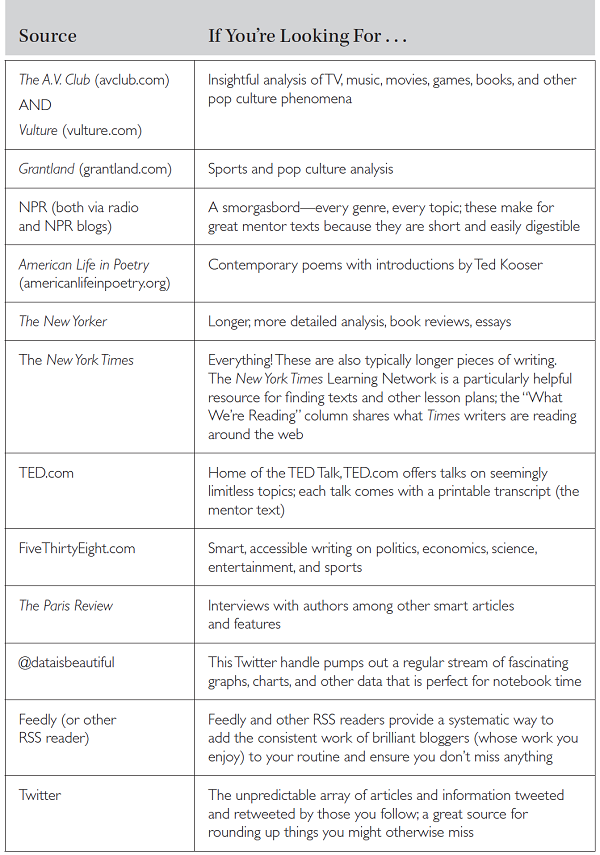
In Writing with Mentors, high school teachers Allison Marchetti and Rebekah O’Dell prove that the key to cultivating productive, resourceful writers—writers who can see value and purpose for writing beyond school—is using dynamic, hot-off-the-presses mentor texts. Today the authors discuss how to find the best mentor texts.
***
When we were first-year teachers, we dreamed of that mythical file cabinet, of the days when all our instructional ducks would be in a row, our planning periods would not be filled with frenzied panic, and we could just pull the perfect text out of the drawer and dazzle students every time. We learned along the way, of course, this isn’t the way mentor texts really work.
On occasion, we do dig out a perennial favorite (like Gary Soto’s memoir “The Jacket”), but in truth we have found very few mentor texts that are actually timeless or relevant to every group of students. Instead of demanding our students fit one text, we find texts to fit our students, and even when we loved a text the year before, we often find something hot-off-the-presses for a new year.
While we certainly have specific plans for a new school year or a new study, we live on the edge a bit, waiting to see what comes alive in the weeks and days immediately before we teach. In fact, the mentor texts we’ll use probably haven’t even been written when we sit down with our planners in August to map out the year. For instance, we know we’ll study editorials with our ninth graders in the winter. We know we’ll explicitly teach skills such as developing a claim and supporting it with evidence, structuring an argument, and acknowledging and responding to the other side. We know this study will take us about three weeks.
With our other plans in place, we spend the weeks and days before we begin our study finding relevant, compelling editorials to mentor our students.
What we don’t know is which mentor texts we will use. In fact, we can’t know what will be happening this winter, what hot topics newspapers and pundits will be discussing, which professional editorials will best connect with the students who’ll be sitting in front of us. So, we wait. With our other plans in place, we spend the weeks and days before we begin our study finding relevant, compelling editorials to mentor our students.
Ultimately, we’ve found that relinquishing some advance planning in favor of the best organic planning accomplishes something wonderful, not just for our students but also for us. While our students receive instruction and inspiration from fresh, current texts, they also receive instruction and inspiration from a fresh, current teacher. Our teaching lives and breathes and stretches when our plans wait and we lean in to the new texts and ideas we find around us as we teach.
Where do these mentor texts come from? On the very best days, they come to us organically. In our daily interactions with the world of words, we find mentor texts everywhere. We find them when we read each day for fun, for knowledge, and for inspiration in our out-of-school lives. We find them in the articles that pop up in our Feedly account in the morning, the stories that catch our eye on The New York Times Twitter feed. When we hear something interesting on NPR during our commute, we make note of it and use it as a mentor text later. Post-It flags dot the pages of our pleasure reading, reminding us to return later and share with our students: Use this paragraph as a mentor text on dialogue.
On those other days—the days on which we are looking for a specific technique or a mentor text for an individual student, or the days when nothing naturally jumps out at us in our reading—we search our go-to sources, which range from pop culture blogs to podcasts to weekly columns and cover a wide range of reading predilections and habits. Figure 2.1 offers a sampling of these sources and the kind of texts we find there.
Finding current, engaging mentor texts doesn’t have to be laborious. What reading interests you? What do you pick up to read throughout the day? What are your favorite magazine, newspapers, websites, and what elements of those might also inspire your students? The key is realize mentor texts are all around you all the time, especially in the places you read every day.
Allison loves poetry, so she subscribes to American Life in Poetry and The Writer’s Almanac. When “Vernal Sentiment” by Theodore Roethke popped up in her inbox, she set it aside so she could use the first stanza to demonstrate how writers move from concrete details to autobiographical significance. When Rebekah happened upon an interesting and nuanced article about How I Met Your Mother, one of her favorite TV shows, she knew it would be just the thing to show her IB students how writers effectively draw comparisons.
Using these hot-off-the-presses texts also reinforces the idea we desperately try to share all year long. The world is full of writers who are alive and interacting with the world. Writers are not just novelists and journalists. They are people like you and me, who love to watch television—or play video games, or go to art galleries, or commune with nature—and write about it.
♦ ♦ ♦ ♦


Allison Marchetti and Rebekah O'Dell teach high school English in Richmond, Virginia. Both graduates of the University of Virginia, they are experienced teachers in both independent and public schools, from inclusion classrooms to AP and IB.
Writing With Mentors: How to Reach Every Writer in the Room Using Current, Engaging Mentor Texts is available September 3.



